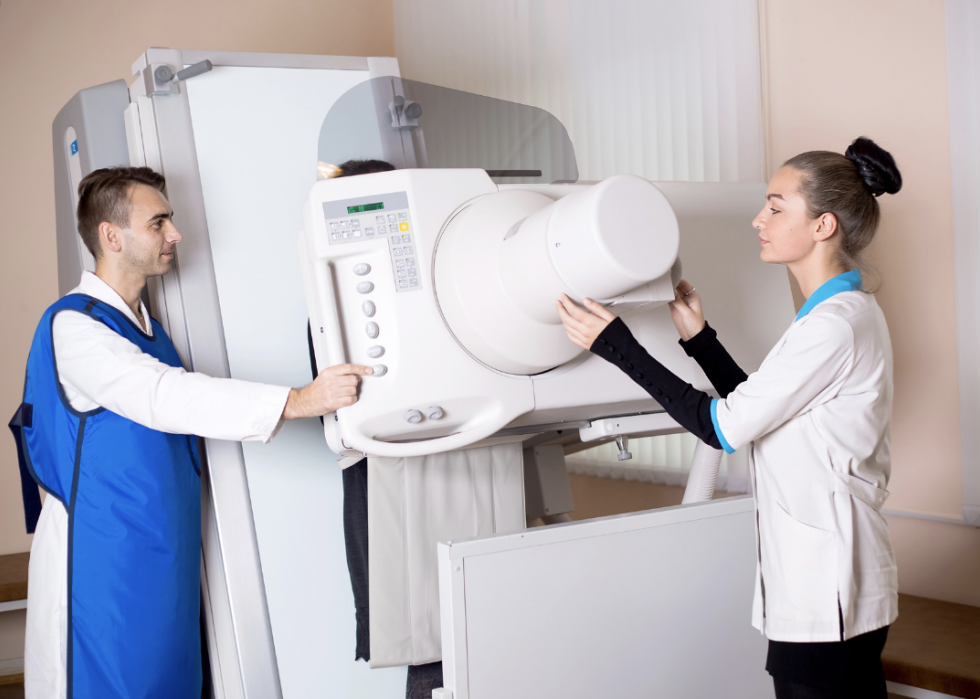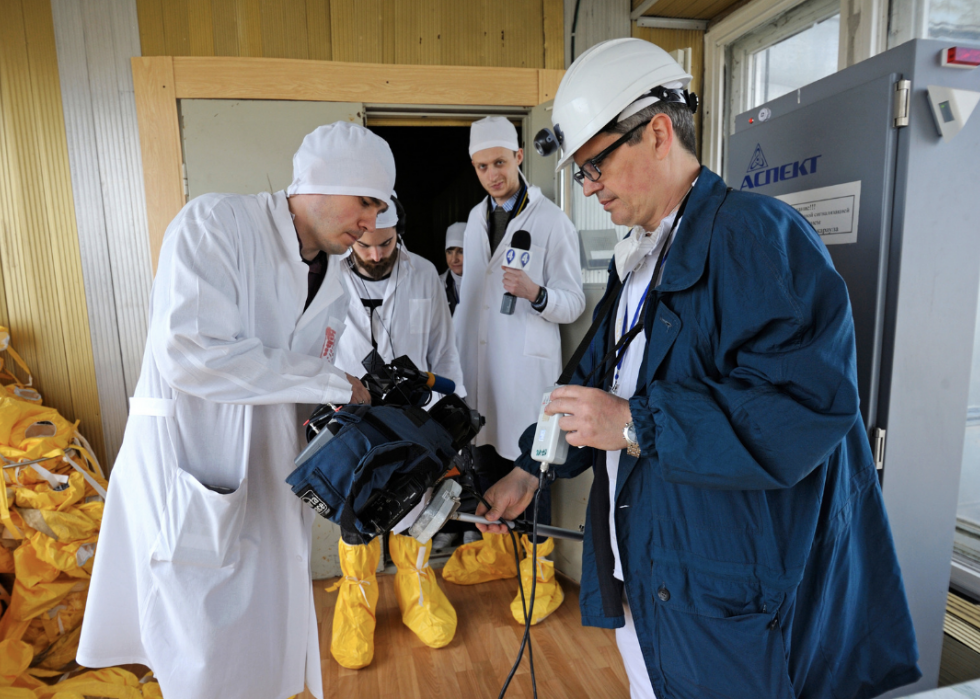
Highest-paying jobs that only require a 2-year degree
Highest-paying jobs that only require a 2-year degree
The American economy is increasingly becoming one in which a high school education is simply not enough. According to Georgetown University's Center on Education and the Workplace, of the 55 million job openings expected from 2010 to 2020, only 36% will require a high school education or less, 30% will require some college or an associate degree, while 35% will require at least a bachelor's degree.
Attaining an associate degree or better for 25- to 29-year-olds increased from 38% to 46% between 2000 to 2017, while bachelors degree attainment or better increased from 29% to 36%, and attainment of master's degrees or higher grew grown from 5% to 9%, according to the National Center for Education Statistics. While the largest percentage of U.S. workers only hold a high school diploma—with the second-highest percentage belonging to those with baccalaureate degrees—the number of holders of an associate or technical degree is rising.
Fortunately, the number of associate degree-friendly positions is growing. Stacker checked the most recent data (Sept. 4, 2019) from the U.S. Bureau of Labor Statistics' Occupational Outlook Handbook to determine the jobs requiring a two-year degree that pay the highest salaries. We looked at the 2018 median annual wage, as well as the projected growth rate from 2018 to 2028 and the expected change in job numbers for the same period. Our listing is ranked by the 2018 annual wage.
For several entries—funeral service managers and morticians, undertakers, and funeral directors, diagnostic medical sonographers and cardiovascular technologists and technicians, mechanical drafters and architectural and civil drafters and magnetic resonance imaging technologists and radiological technologists—the employment and growth data listed reflect both jobs and is noted below when appropriate.
With many believing that the cost of a four-year education too high, given the rising cost of tuition and stagnant wage growth, it's encouraging to know that there are obtainable, well-paying professions for those with a two-year degree. While a bachelor's degree holder can be expected to make about $500,000 more in lifetime earnings compared with an associate degree holder, the jobs we have listed show the exceptions.
Keep reading to learn about some well-paying gigs you can land with an associate degree.
You may also like: Most trusted professions in America

#42. Dietetic technicians
- 2018 median annual wage: $27,140
- Employment in 2018: 34,800
- Projected employment in 2028: 36,900
- Projected growth rate 2018-2028: 2,000 (5.8%)
Dietetic technicians are food and nutrition technical practitioners who typically work with dietitian nutritionists to help determine the nutritional needs of their clients and prepare foods for those with special dietary needs. This can be as part of a medically prescribed treatment regime, in an educational setting teaching about the importance of proper nutrition, or as part of the food-service industry.

#41. Preschool teachers, except special education
- 2018 median annual wage: $29,780
- Employment in 2018: 523,600
- Projected employment in 2028: 560,500
- Projected growth rate 2018-2028: 36,900 (7.1%)
Preschool teachers provide basic daycare services, rudimentary education, and social-interaction training for children too young for a traditional school setting. These services can be instrumental in childhood development, and preparation for more-formalized institutional learning.

#40. Veterinary technologists and technicians
- 2018 median annual wage: $34,420
- Employment in 2018: 109,400
- Projected employment in 2028: 130,500
- Projected growth rate 2018-2028: 21,100 (19.3%)
Veterinarian technologists and technicians conduct medical and laboratory tests to help diagnose injuries and illnesses in animals. While a veterinarian technologist typically requires a bachelor degree, a technician only needs an associate degree. Both positions require a credentialling examination and state licensing or certification.

#39. Human resources assistants, except payroll and timekeeping
- 2018 median annual wage: $34,520
- Employment in 2018: 129,300
- Projected employment in 2028: 123,900
- Projected growth rate 2018-2028: -5,300 (-4.1%)
Human resources assistants create and maintain employee records regarding hiring and termination, attendance records, addresses and personal information, and other workplace concerns such as uniform requests. Human resources assistants also may keep track of production, produce performance reports, and/or provide employment verification.

#38. Forest and conservation technicians
- 2018 median annual wage: $37,180
- Employment in 2018: 32,700
- Projected employment in 2028: 33,300
- Projected growth rate 2018-2028: 600 (1.7%)
A forest and conservation technician manages forest natural resources. The technician may work with a forester to compile reports on various forest tracts or may work independently to train and supervise forest workers, to coordinate forest replanting and propagation, and to manage fire suppression.

#37. Agricultural and food science technicians
- 2018 median annual wage: $40,860
- Employment in 2018: 29,200
- Projected employment in 2028: 31,000
- Projected growth rate 2018-2028: 1,800 (6.1%)
Agricultural technicians work with agricultural scientists to manage livestock and plant stocks to improve yields. This may include performing tests to improve plant resistance to disease or assisting in animal breeding. Food science technicians work with food scientists to improve the packaging, processing, and production of processed foods.

#36. Desktop publishers
- 2018 median annual wage: $42,910
- Employment in 2018: 12,600
- Projected employment in 2028: 10,600
- Projected growth rate 2018-2028: -2,000 (-15.9%)
Desktop publishers use computer software to manipulate and edit photos and videos, to transcode and compress media files, and to create web pages and print-ready publications. The job may demand an understanding of an array of programs—including font managers, word processing suites, and data converters—as well as knowledge of printers and scanners.

#35. Broadcast technicians
- 2018 median annual wage: $43,660
- Employment in 2018: 35,300
- Projected employment in 2028: 35,700
- Projected growth rate 2018-2028: 400 (1.1%)
Producing programming for broadcast is complicated. Not only must audio feeds be combined in a proper balance, but cameras must be calibrated and coordinated, lighting must be at proper levels, all electrical signals must be properly monitored, and the processing hardware must be in working order. Broadcast technicians take care of all this, as well as ensure that the program is properly transmitted. Both radio and television use broadcast technicians.

#34. Embalmers
- 2018 median annual wage: $44,250
- Employment in 2018: 4,200
- Projected employment in 2028: 4,100
- Projected growth rate 2018-2028: -100 (-1.9%)
Embalmers preserve corpses for burial or interment. Embalming—while not technically necessary because of refrigeration—allows for better presentation of the body during a wake and funeral. Some municipalities mandate embalming, however. Embalming requires an understating of anatomy, surgical procedures, chemistry, and thanatology (the science of death and how death affects the body).

#33. Environmental science and protection technicians, including health
- 2018 median annual wage: $46,170
- Employment in 2018: 34,800
- Projected employment in 2028: 38,000
- Projected growth rate 2018-2028: 3,200 (9.2%)
An environmental science and pollution technician collects samples and performs experiments to determine the cause of environmental pollution. This may include taking air, water, and soil samples. Those in this job typically work under an environmental scientist, a pollution engineer, or an equivalent specialist.

#32. Physical therapist assistants
- 2018 median annual wage: $48,090
- Employment in 2018: 98,400
- Projected employment in 2028: 125,000
- Projected growth rate 2018-2028: 26,700 (27.1%)
Physical therapist assistants work with physical therapists to help with the physical rehabilitation and retraining of patients and clients. This may include helping clients perform specific exercises, applying therapies and treatment plans, and providing other help as needed.

#31. Chemical technicians
- 2018 median annual wage: $48,160
- Employment in 2018: 70,300
- Projected employment in 2028: 71,500
- Projected growth rate 2018-2028: 1,200 (1.7%)
Chemical technicians assist chemists in various laboratory procedures needed to fabricate chemical compounds. This may include conducting quality control tests, monitoring feed lines, maintaining environmental standards for discharges and byproducts, and working on research for new products.

#30. Medical equipment repairers
- 2018 median annual wage: $49,210
- Employment in 2018: 53,800
- Projected employment in 2028: 55,800
- Projected growth rate 2018-2028: 2,000 (3.8%)
Medical equipment repairers diagnose and correct faulty or broken medical equipment, such as hearing aids, wheelchairs, eyeglasses, and dialysis equipment. This group includes biomedical equipment repairers—who fix equipment such as diagnostic ultrasound machines, mammograph scanners, MRI scanners, and computer tomography scanners—and dental equipment technicians.

#29. Environmental engineering technicians
- 2018 median annual wage: $50,560
- Employment in 2018: 17,900
- Projected employment in 2028: 19,500
- Projected growth rate 2018-2028: 1,500 (8.6%)
Environmental engineering technicians work in site remediation. Their job is to reduce the amount of environmental pollutants in an area, including waste treatment, and to modify and operate equipment to control and prevent environmental issues. Environmental engineering technicians typically work under the direction of an environmental engineer or environmental scientist.

#28. Paralegals and legal assistants
- 2018 median annual wage: $50,940
- Employment in 2018: 325,700
- Projected employment in 2028: 364,800
- Projected growth rate 2018-2028: 39,000 (12.0%)
Paralegals are law office assistants that aid in the preparation, processing, and researching of legal actions and court cases. They usually handle matters that do not require a lawyer, or help to cut the workload of a law office staff.

#27. Respiratory therapy technicians
- 2018 median annual wage: $51,210
- Employment in 2018: 9,300
- Projected employment in 2028: 3,900
- Projected growth rate 2018-2028: -5,300 (-57.5%)
Respiratory therapy technicians work with respiratory therapists to apply prescribed treatments to the respiratory system. These include offering prescribed medications, applying and monitoring diagnostic and treatment equipment, and/or supervising rehabilitation exercises and procedures.

#26. Civil engineering technicians
- 2018 median annual wage: $52,580
- Employment in 2018: 73,800
- Projected employment in 2028: 77,400
- Projected growth rate 2018-2028: 3,700 (5.0%)
A civil engineering technician works with civil engineers to monitor and test the construction and current state of buildings and other structures. These can include tunnels, bridges, airports, train terminals, power utilities, and other public assets.

#25. Morticians, undertakers, and funeral directors
- 2018 median annual wage: $52,650
- Employment in 2018: 29,600
- Projected employment in 2028: 30,300
- Projected growth rate 2018-2028: 800 (2.6%)
Note: Employment and job growth statistics account for all funeral service workers
In some states, there is no legal difference among an embalmer, an undertaker, a funeral director, and a mortician. In others, a funeral director is the official who oversees a funeral, including buying coffins and the interment site, preparing the body, coordinating with the officiant, preparing all needed legal forms, and scheduling and planning the funeral and interment. Embalmers and other funeral staff may work under the funeral director.

#24. Geological and petroleum technicians
- 2018 median annual wage: $53,300
- Employment in 2018: 16,300
- Projected employment in 2028: 17,400
- Projected growth rate 2018-2028: 1,100 (6.6%)
Finding precious metals or oil can be challenging. It typically depends on luck and many years of laboratory testing on soil and water samples. Geological and petroleum technicians are the specialists who conduct those tests. They look at laboratory readings, as well as equipment readings from boring and mining operations, to determine if new minerals are present or if current mining operations should be adjusted.

#23. Computer network support specialists
- 2018 median annual wage: $53,470
- Employment in 2018: 191,300
- Projected employment in 2028: 203,400
- Projected growth rate 2018-2028: 12,200 (6.4%)
Computer network support specialists aid network users regarding the access of networked assets and files or technical concerns about the network's terminals or servers. This job requires the specialists to have a detailed understanding of server software and equipment, troubleshooting protocols, and customer service skills.

#22. Radio, cellular, and tower equipment installers and repairers
- 2018 median annual wage: $54,890
- Employment in 2018: 14,200
- Projected employment in 2028: 14,600
- Projected growth rate 2018-2028: 300 (2.3%)
Radio, cellular, and tower equipment installers and repairers service and equip mobile and stationary radio transmission equipment for ship-to-shore, aircraft-to-ground, emergency responder, mobile broadband, and cellular communications. These specialists typically test and ensure the network's coverage by handling high-voltage equipment that requires extensive on-the-job training and safety precautions.

#21. Architectural and civil drafters
- 2018 median annual wage: $54,920
- Employment in 2018: 101,200
- Projected employment in 2028: 103,000
- Projected growth rate 2018-2028: 1,800 (1.8%)
Note: Employment and job growth statistics account for all types of drafters
Architectural drafters take specifications from an architect and prepare detailed drawings and plans for the construction of buildings and other structures. This may include drawing the foreman's plans or plans to be officially filed. Civil drafters prepare the topographical and relief maps for bridges, highways, and other public works projects.

#20. Industrial engineering technicians
- 2018 median annual wage: $55,460
- Employment in 2018: 68,300
- Projected employment in 2028: 67,800
- Projected growth rate 2018-2028: -500 (-0.8%)
Industrial engineering technicians work with industrial engineers to improve the production process in manufacturing. This may include studying workers' motions and work procedures, reviewing safety protocols, and enacting methods to improve productivity.

#19. Mechanical drafters
- 2018 median annual wage: $55,920
- Employment in 2018: 58,000
- Projected employment in 2028: 54,000
- Projected growth rate 2018-2028: -4,000 (-6.9%)
Note: Employment and job growth statistics account for all types of drafters
Like architectural and civil drafters, mechanical drafters produce schematics of machinery for production. These schematics are typically based on designs and sketches from mechanical engineers, industrial designers, or product designers.

#18. Mechanical engineering technicians
- 2018 median annual wage: $56,250
- Employment in 2018: 42,600
- Projected employment in 2028: 43,800
- Projected growth rate 2018-2028: 1,100 (2.6%)
In this job, employees work with mechanical engineers to develop, modify, test, and calibrate machinery. Mechanical engineering technicians typically work under the direction of physical scientists or mechanical engineers.

#17. Cardiovascular technologists and technicians
- 2018 median annual wage: $56,850
- Employment in 2018: 57,800
- Projected employment in 2028: 61,700
- Projected growth rate 2018-2028: 3,800 (6.6%)
Note: Employment and job growth statistics account for both diagnostic medical sonographers and cardiovascular technologists and technicians
Cardiovascular technologists and technicians conduct tests on patients' respiratory and circulatory systems for diagnostic and preventative purposes. Tests can include lung capacity, electrocardiograms, and other procedures.

#16. Occupational therapy assistants
- 2018 median annual wage: $57,620
- Employment in 2018: 43,800
- Projected employment in 2028: 58,300
- Projected growth rate 2018-2028: 14,500 (33.1%)
Occupational therapy assistants work with occupational therapists to help patients recover from disabilities, injuries, and impairments. They can help with speech therapy, clinical psychology, long-term nursing care and social work, and physical therapy.

#15. Electro-mechanical technicians
- 2018 median annual wage: $57,790
- Employment in 2018: 14,000
- Projected employment in 2028: 14,100
- Projected growth rate 2018-2028: 100 (0.7%)
Electro-mechanical technicians operate, maintain, and calibrate electromechanical equipment. Their roles can include operating remote equipment, monitoring autonomous equipment, or operating critical-response equipment—such as hazardous waste removal rigs.

#14. Radiologic technologists
- 2018 median annual wage: $59,520
- Employment in 2018: 210,500
- Projected employment in 2028: 229,500
- Projected growth rate 2018-2028: 19,000 (9%)
Note: Employment and job growth statistics account for both radiologic and MRI technologists
Radiological technologists, also called radiographers, operate radiological imaging diagnostic equipment such as CT scanners and X-ray machines. These technicians typically work in a hospital setting in nuclear medicine/radionuclide imaging, mammography, sonography, computed tomography, and echocardiography.

#13. Respiratory therapists
- 2018 median annual wage: $60,280
- Employment in 2018: 134,000
- Projected employment in 2028: 162,000
- Projected growth rate 2018-2028: 27,900 (20.8%)
Respiratory therapists provide medical treatment to patients with breathing disorders, and offer diagnostic and long-term care services. Respiratory therapists typically work under the auspices of a physician and conduct prescribed therapies, administer medications, operate and maintain therapeutic equipment, and update patients' records.

#12. Avionics technicians
- 2018 median annual wage: $63,060
- Employment in 2018: 20,600
- Projected employment in 2028: 21,000
- Projected growth rate 2018-2028: 400 (2.2%)
Avionics technicians maintain and assemble equipment related to air and space flight. This includes missile control systems and launch assemblies, radar arrays, navigation systems, and radio systems. This, however, typically excludes on-board equipment or flight assemblies, which usually are covered under aviation engineering.

#11. Electrical and electronics engineering technicians
- 2018 median annual wage: $64,330
- Employment in 2018: 130,500
- Projected employment in 2028: 130,700
- Projected growth rate 2018-2028: 200 (0.2%)
Electrical and electronics engineering technicians help electrical and electronic engineers in the assembly and maintenance of electrical generation, electrical distribution, and electrical monitoring equipment, as well as electrical devices and electronics. This may involve an understanding of circuit design, semiconductor operation, electromagnetism, and ferromagnetism.

#10. Aerospace engineering and operations technicians
- 2018 median annual wage: $67,010
- Employment in 2018: 10,500
- Projected employment in 2028: 11,000
- Projected growth rate 2018-2028: 500 (4.5%)
Aerospace engineering and operations technicians install and operate systems critical to air and space flight, including simulators, on-board operation consoles, testing equipment, position trackers, and operational computers. These technicians also may collect and interpret test data to improve flight performance.

#9. Web developers
- 2018 median annual wage: $69,430
- Employment in 2018: 160,500
- Projected employment in 2028: 181,400
- Projected growth rate 2018-2028: 20,900 (13%)
Web developers are a subset of desktop publishers who design, program, and implement interactive websites and web services. This include programming scripts, laying out web-page elements, and properly uploading media files to web servers.

#8. Magnetic resonance imaging technologists
- 2018 median annual wage: $71,670
- Employment in 2018: 39,400
- Projected employment in 2028: 43,700
- Projected growth rate 2018-2028: 4,300 (10.9%)
Note: Employment and job growth statistics account for both radiologic and MRI technologists
Magnetic resonance imaging is a type of radiological medical imaging that uses strong magnetic fields and radio waves to produce an image of soft tissues in the body without X-rays or ionizing radiation. MRIs are useful for medical diagnoses and disease staging, where multiple scans may be needed. Magnetic resonance imaging technologists operate the MRI scanner and prepare MRI scans.

#7. Diagnostic medical sonographers
- 2018 median annual wage: $72,510
- Employment in 2018: 72,900
- Projected employment in 2028: 87,100
- Projected growth rate 2018-2028: 14,200 (19.5%)
Note: Employment and job growth statistics account for both diagnostic medical sonographers and cardiovascular technologists and technicians.
Another type of radiographer, a diagnostic medical sonographer uses sonographs or ultrasonic frequency recordings to look at internal organs and tissues. The most common use of diagnostic medical sonographers is during prenatal examinations, during which the physician may request a scan of the developing fetus.

#6. Dental hygienists
- 2018 median annual wage: $74,820
- Employment in 2018: 219,800
- Projected employment in 2028: 243,500
- Projected growth rate 2018-2028: 23,700 (10.8%)
Dental hygienists are health care professionals who offer cleaning and other non-surgical procedures for dental patients. This may include periodontal scaling and treatment, prophylaxis, and periodontal maintenance. Dental hygienists also may provide surgical assistance to dentists.

#5. Nuclear medicine technologists
- 2018 median annual wage: $76,820
- Employment in 2018: 19,300
- Projected employment in 2028: 20,600
- Projected growth rate 2018-2028: 1,300 (6.9%)
Nuclear medicine is the application of ionizing radiation or radioactive substances for the treatment and diagnosis of a disease. Typically, a patient consumes a radioactive drug. Detectors then track the radioactivity being emitted from the patient's body, forming an image of the patient's internal organs. This test can show how an organ or tissue is operating in real time, as opposed to an X-ray which is just an image.

#4. Nuclear technicians
- 2018 median annual wage: $79,140
- Employment in 2018: 7,600
- Projected employment in 2028: 7,300
- Projected growth rate 2018-2028: -300 (-4.1%)
Nuclear technicians operate and maintain nuclear reactors and other ionizing radiation emitters, including imaging devices and medical equipment. The techs typically work under nuclear physicists, nuclear engineers, or similarly trained scientists.

#3. Funeral service managers
- 2018 median annual wage: $79,180
- Employment in 2018: 23,500
- Projected employment in 2028: 24,700
- Projected growth rate 2018-2028: 1,200 (5.2%)
Note: Employment and job growth statistics account for all funeral service workers
A funeral service manager is equivalent to a funeral service director in some states. In others, for large funeral service providers, funeral service managers are the senior administrators. They set prices for services and products offered, establish policies, and coordinate advertising strategies.

#2. Radiation therapists
- 2018 median annual wage: $82,330
- Employment in 2018: 18,600
- Projected employment in 2028: 20,200
- Projected growth rate 2018-2028: 1,600 (8.5%)
Radiation therapists apply radiation therapy to patients for diagnostic and prescribed applications. They typically work with radiologists in cancer treatments, record-keeping, and in equipment operation and service.

#1. Air traffic controllers
- 2018 median annual wage: $124,540
- Employment in 2018: 24,300
- Projected employment in 2028: 24,600
- Projected growth rate 2018-2028: 300 (1.3%)
Air traffic controllers coordinate air traffic within a specific air space and grant permission to enter (takeoff) and leave (land). This includes coordinating flight information among neighboring air towers and tracking location, altitude, and speed information for all local flights in real time. Air traffic controllers also must respond to emergency conditions and record violations of national and institutional ordinances.
You may also like: Billionaires that live in the smallest American towns



